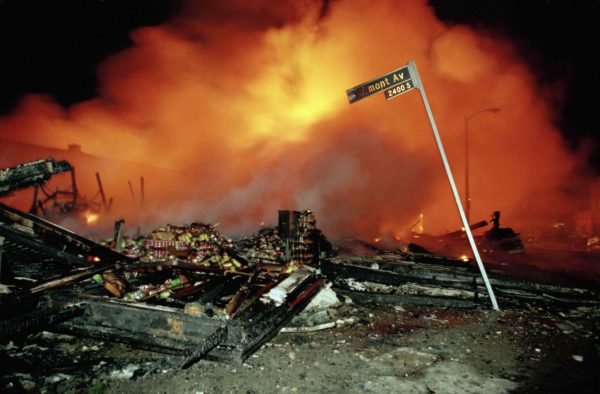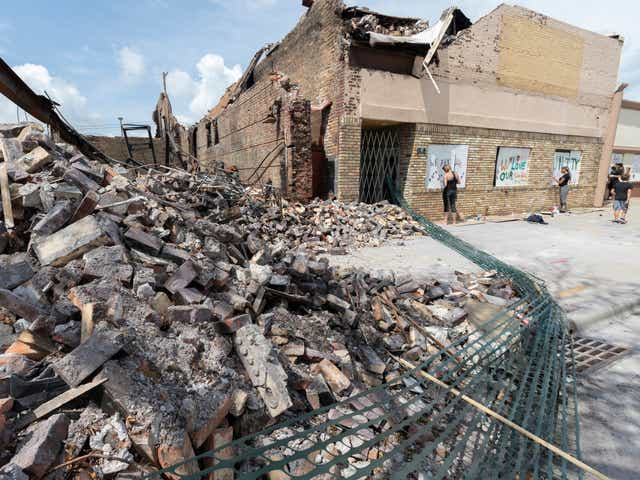We've honored a slave-trading tyrant for far too long.
The Rebellion of America’s New Underclass

Serf's up.
Like so many before them, our recent disorders have been rooted in issues of race. But in the longer run, the underlying causes of our growing civic breakdown go beyond the brutal police killing of George Floyd. Particularly in our core cities, our dysfunction is a result of our increasingly large, and increasingly multi-racial, class of neo-serfs.
Like its Medieval counterpart, today’s serf class consists of the permanently marginalized—like the peasants of feudal times, these people are unlikely to move to a higher station. This does not only apply to the residents of our ghettos and barrios. Many of our young people, white and otherwise, appear to have little or no hope of attaining the usual milestones of entry into the middle class—gaining a useful and marketable skill, starting a small business, or buying a home or other property.
Throughout much of the 20th century, this aspiration was very much alive as more and more people, including racial minorities and immigrants, entered the middle ranks. Now, in contrast, the doors are slamming shut for millions of Americans.
This trend has been made worse by the lockdowns surrounding the pandemic. Almost 40% of those Americans making under $40,000 a year have lost their jobs. The unemployment rate of those with less than a high-school diploma jumped from 6.8% on the month to 21.2%. For college graduates, it rose from 2.5% to 8.4%. Salaried workers have been laid off at roughly half the rate of hourly workers.
The biggest drops in hiring have been concentrated in recreation and travel, largely “personal contact” jobs that employ many low-wage workers. Employment in this sector has dropped 70% while remaining remarkably stable throughout the public sector and in such fields as computer networking.
Many young people, including college graduates, are now often employed in these low-wage industries. They are suffering the largest share of our job losses for any age group. In a new report, Data for Progress found that a staggering 52% of people under the age of 45 have lost a job, been put on leave, or had their hours reduced due to the pandemic.
This class of underemployed and unemployed youths appears to be represented among the rioters and looters that took advantage of peaceful and legitimate protests. Particularly telling has been the role played by predominately white radicals—whom Mike Lind hilariously labels “riot ninjas.” Although often emerging from largely privileged backgrounds, radicals—whether part of anti-fa or just freelance—can be seen as putting into action the political indoctrination they imbibed in college and, increasingly, even earlier.
The agenda of the new activists is nothing less than a total assault on the bourgeoisie. Protest leaders, such as Black Lives Matter-LA’s Melina Abdulla, believe that “the rebellion” must extend into upscale urban areas. This approach works well not only for socialist revolutionaries but for the financial advantage of criminal gangs exploiting the chaos.
Hence the trashing of iconic L.A. shopping destinations like The Grove, the Beverly Center, and Rodeo Drive, as well as such upper-income bastions as Uptown in Minneapolis, Atlanta’s Buckhead, Seattle’s suburban Bellevue, historic Washington, D.C., and the Barclay Center in downtown Brooklyn. In Chicago, city officials, much like Medieval counterparts, raised the bridges over the Chicago River to keep the protestors out of the swanky part of the central city.
History also Regresses
More than the race riots of the 1960s or previous modern social explosions, which mainly were confined to ghettos and barrios, the current wave resembles the peasant rebellions that periodically swept Medieval societies. These upheavals—such as Watt Tyler’s rebellion in England and the Jacquerie in France—devolved into brazen attacks on the property and persons of the upper classes which led to bloody aristocratic reprisals. The heads of rebels were sometimes hung on spikes as a warning to others.
Such a “back to the future” regression contradicts notions, held dear by many heirs of the Bush Right and Obama Left, of an “arc of history” bending inexorably toward greater social progress. Like Rome in the waning years of classical civilization, our society seems to be moving backward, away from greater prosperity and enlightenment and toward a more hierarchical, controlled, and economically and demographically stagnant reality.
We appear to be watching the end of a remarkable period which saw, first, the ascendency of the middle class and then, particularly after World War II, the steady improvement of conditions for the working class. Now this progress has ground to a halt, a trend greatly accelerated by the COVID-19 pandemic. In the United States, long seen as the great land of opportunity, the chance of middle-class earners moving up to the top rungs of the earnings ladder has dropped by approximately 20% since the early 1980s.
America’s economic regression is best understood in generational terms. About 90% of those born in 1940 grew up to earn higher incomes than their parents, according to researchers at the Equality of Opportunity Project. The same is true for only 50% of those born in the 1980s.
A Deloitte study projects that Millennials in the United States will hold barely 16% of the nation’s wealth in 2030, when they will be the largest adult generation by far. Gen Xers, the preceding generation, will hold 31%, while Boomers, entering their eighties and nineties, will still control 45% of the nation’s wealth.
Urban Gentrification and the Current “Rebellion”
The recent spate of rioting reflects how little the urban renaissance has done for its poorer citizens. In fact, the number of high-poverty urban areas has grown steadily over the past few decades and doubled in population between 1980 and 2018. Decades ago, the National Urban Coalition noted that urban revitalization programs generally produced some overall economic benefit for cities, but at the cost of “the deprivation, frustration and anger of those who are becoming the new urban serfs.”
The current trashing of the urban “glamour zone” can be seen as the expression of a deep-seated, decades-long resentment of gentrification in many cities, such as Denver, Oakland, Los Angeles, and New Orleans. Tactics for repelling gentrifiers—well before the current unrest—have included vandalism and even arson.
Lack of enthusiasm among minorities for the recent urban revival is certainly understandable. As places like the Chicago loop have expanded and thrived, poverty across vast parts of the southside has grown—many districts barely had retail even before COVID and the rest.
Jawanza Malone, executive director of Chicago’s Kenwood-Oakland Community Organization, sees the devastation around him as linked to neglect on the part of city leaders, who give priority to real estate speculation and the high-end economy. “This isn’t natural; this was created,” says Malone. The lack of investment in those areas by the city government or the private sector reflects their “perceived lack of importance to the city. It’s a signal that residents here aren’t as important.”
To be sure, COVID-19, like earlier pandemics throughout history, further devastated these poorer communities. People who live in crowded housing, are forced to ride transit, and work in the most exposed “essential” jobs (most of them low-paying) are bound to be disproportionately affected by a public health crisis. The impoverished Bronx has suffered nearly twice as many deaths from COVID as affluent Manhattan, despite the latter’s higher population density.
Particularly impacted, first by lockdowns and then by the riots, have been urban small business owners. Many of these are ethnic minorities who, according to the California Restaurant Association, own 60% of my adopted home state’s dining establishments. Yet like small businesses across the country, many of these firms have not been able to access federal funds to withstand the downturn. They understandably feel angry and betrayed.
“There is a lot of resentment out there now,” notes long-time East LA activist Rudy Espinoza. “People are struggling more than ever and many of them blame the government for letting them down.”
The Rebellion of the Déclassé
The most distinctive element of these disorders has been the intelligentsia’s almost wholly unqualified embrace of what urban historian Fred Siegel calls “the riot ideology.” This ideology holds that arson, looting, and even assault are legitimate and justifiable activities. Leftist outlets such as Slate, Vox, and Mother Jones excuse such violence “a reasonable reaction” to outrage over the Floyd murder. They imply that anyone who labels these disturbances as “riots” is clearly racist.
It has been still more amazing to see riot ideology embraced by top law enforcement officials such as Massachusetts Attorney General Maura Healey, and echoed by remarkably inept Mayors like Minneapolis’s Jacob Frey. Generally, the progressives have been unwilling to confront the role of largely white, anarchist groups, like Antifa, whose mostly youthful members can be seen on videos egging on violence—even against the objections of African-American protestors.
Some of the radical anger is understandable. Millennials were being screwed economically well before COVID-19, with wages that average 20% lower than previous generations. According to a recent study by the Federal Reserve Bank of St. Louis, the current younger generation are in danger of becoming a “lost generation” in terms of wealth accumulation. The pandemic promises to make the bad even worse.
Particularly vulnerable are the two thirds between 25 and 32 who lack a 4-year college degree. In the past, these workers would have been employed in factories (perhaps with the support of a union), worked in a small business, or even started one. You do not need a Ph.D. to operate a donut shop, a gym, or a hair salon. But these options seem to be disappearing, as evidenced by falling rates of business formation, particularly among the young.
Yet even educated youth now suffer consistently lower wages than their counterparts from previous generations, notes the Pew Research Center. A recent analysis of Federal Reserve data shows that young Americans with a college degree are experiencing stagnant wages. While an elite degree opens doors to the upper strata of society, the same is far from true of all college degrees. Upwards of 40% of recent college graduates now work in jobs that do not typically require a college degree.
This generation, including many from a solidly middle-class background, is increasingly troubled. Some recent research suggests that the pandemic may impact their mental and physical health, leading to shortened lifespans.
Before the pandemic, about 8% of American teens tried to kill themselves each year, and about 70% suffered from loneliness. In 2020, these numbers will likely be higher. The young generation is already more likely to report poor mental health, per the American Psychological Association, and suicides among people ages 10-24 soared 56% from 2007 to 2017.
This likely reflects the pessimism felt by Millennials are about the future. Most expect not to do better than their parents. Their dismal prospects can be seen in their marriage rates—the lowest in history—and in their reluctance to start families. Battered now by pestilence and its aftermath, they could well become what one conservative writer referred to as a “resentful generation.” This would prove a shock to the system for both parties.
Will America go Red?
If they go to the polls, the new generation will certainly opt for Joe Biden—by as much as two to one, according to a recent Harvard survey. But the genial establishmentarian has never been a favorite of the young, many of whom favored Bernie Sanders. The Vermont socialist dominated voters under 30 across the country. In California, according to exit polls, Sanders received 57% of support among young voters, Warren 12%, and Joe Biden a pathetic 5%. By 2024, Millennials will be the country’s biggest voting bloc.
Although Sanders’s rumpled demeanor and passion won him affection from many young people, his radical politics commanded the greatest appeal. Overall, among young Democrats, support for socialism is now greater than capitalism. Even some 56% of Texas Democrats, many of them young and Hispanic, view socialism favorably. Increasingly they no longer believe in the American system and are less patriotic and religious than previous generations.
Not surprisingly, then, Millennials tend to support massive government programs as a way to address social and economic problems by wide margins. A poll conducted by the Communism Memorial Foundation in 2016 found that 44% of American Millennials favored socialism while 14% chose fascism or Communism.
Perhaps because they no longer respect the basic founding principles, Millennials are also far more likely than their elders to accept limits on freedom of speech. Some 40% of Millennials, notes the Pew Research Center, favor suppressing speech deemed offensive to minorities—well above the 27% among Gen Xers, 24% among baby boomers, and only 12% among the oldest cohorts, many of whom remember the fascist and Communist regimes of the past.
Can We Slow the Growth of the Serf Class?
Increasingly, our societies face a difficult choice. Without a greater and more dispersed expansion of democratic capitalism, the only alternative to constant disorder may be massive growth instead of the welfare state. This approach might take the form of “oligarchic socialism,” the kind of guaranteed income widely endorsed among the tech elite—who clearly benefited from the pandemic. This represents, in Marx’s phrase, “the proletarian alms bag” that can keep both destitution, and social revolution, at bay while allowing the ultrarich to maintain their dominance.
Certainly even the most blinkered geeks realize that scenes on the streets of places like San Francisco, where obscene wealth is surrounded by disorderly, malodorous and chaotic streets, cannot be sustained forever. Some massive injections of public money will be critical just to maintain basic order.
But this is not a call for renewed upward mobility. Indeed some on the Left, notably in the environmental community, see the lockdowns not as tragedy but as a “fire drill” for future actions to force people to reduce consumption and live as the privileged nomenklatura sees fit.
Such an approach all but guarantees a succession of new peasant rebellions, a predictable middle class backlash, and ever-escalating demands for ever-higher transfer payments, with some proposing $8000 monthly for families of four during the pandemic. This would make work hardly worthwhile for most, and turn politics into a game to satisfy poorer citizens with “bread and circuses,” as was the case in Rome.
Sadly, this approach will do little to encourage upward mobility. It will simply nurture and expand the serf class. These young people, and inner-city residents, deserve something more than cheap expressions of sympathy and solidarity from the affluent. They need to develop a new urban paradigm that boosts opportunities rather expanding serfdom. Only by restoring broad upward mobility can we hope to maintain a healthy democratic society.
The American Mind presents a range of perspectives. Views are writers’ own and do not necessarily represent those of The Claremont Institute.
The American Mind is a publication of the Claremont Institute, a non-profit 501(c)(3) organization, dedicated to restoring the principles of the American Founding to their rightful, preeminent authority in our national life. Interested in supporting our work? Gifts to the Claremont Institute are tax-deductible.
The Left perfects the mob veto.
Joe’s sudden attempt to play cop is pitifully transparent.
The Left is losing the argument, so they want to burn it down.
Wisconsin will be the new normal unless the Right puts its foot down.
Between the abyss and what goes on in Portland and the Magnificent Mile, there is for the moment nothing else but Trump standing in the breach.





